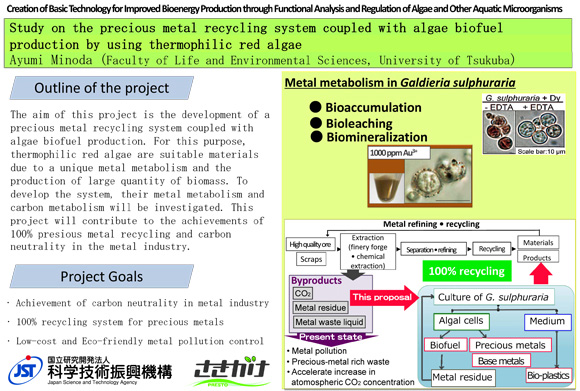PRESTO PhaseII
Munehito Arai

- Associate Professor, Graduate School of Arts and Sciences, The University of Tokyo
Improvement of cyanobacterial enzymes for alkane biosynthesis
To improve alkane biosynthesis in cyanobacteria, we develop highly active mutants of cyanobacterial enzymes for alkane biosynthesis by two complementary approaches. First approach is rational design of the mutants based on crystal structures of the enzymes. Second one is empirical design based on "mutanome analysis", in which a comprehensive database is created on changes in the enzymatic activity upon systematic mutations.
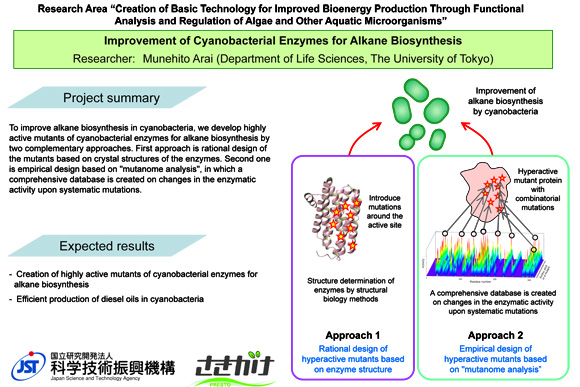
Takuro Ito

- Project Research Associate, Institute for Advanced Biosciences, Keio University
Lipids accumulation metabolism in microalgae
Some unicellular green algae arrest growth and accumulate intercellular neutral lipids under stress conditions, and these algae are promising candidates for the feedstock for the next-generation biofuel. In this project, the metabolic flow of Chlamydomonas reinhardtii, a model green algae, is studied based on the time-resolved metabolome analysis using stable isotope, and highly lipids-accumulating strains is established.
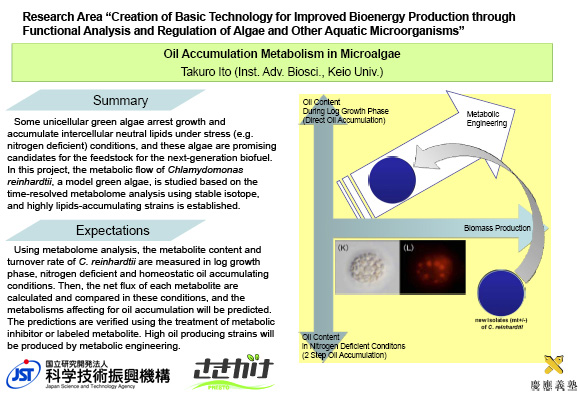
Masakazu Iwasaka

- Professor, Research Institute for Nanodevice and Biosystems, Hiroshima University
Achievement of solar energy transformation by utilizing micro-mirrors in aquatics
The aim of this study is to develop a new solar energy transformation technique by utilizing micro-mirrors in aquatics. The micro-mirror, which is a biological photonic crystal in the structural-color-indicating tissue, such as guanine crystals of fish scales and lorica of algae, is investigated to explore a key mechanism for an effective transfer of mechanical and solar energy. The goal of this study is the attainment of magnetic modulation of micro-mirror alignments in the presence of Brownian motion that will bring new concepts for solar energy exchange and transfer technologies.
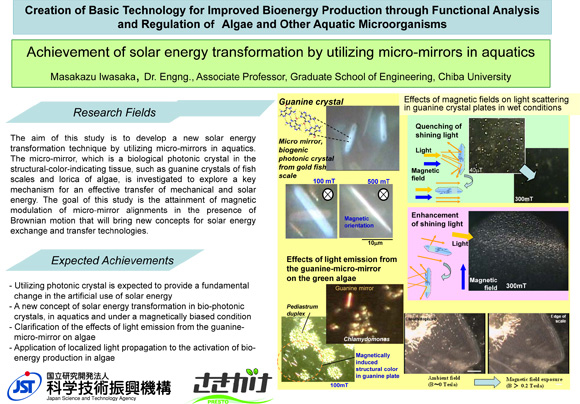
Daisuke Umeno

- Associate Professor, Department of Applied Chemistry and Biotechnology, Chiba University
Molecular breeding of microalgal for the production of isoprenoid fuels and chemicals
Isoprenoids cover diverse set of structures including various industrial valuables such as drugs, pigments, fragrances, materials, and fuel compounds. To establish an efficient route from carbon dioxide to various isoprenoids, artificial isoprenoid pathways, including numbers of laboratory-evolved enzymes, will be constructed and installed into various photosynthetic bacteria. By adding the dynamic controller of the pathway components, we try to establish an efficient operation of these high-power pathways.
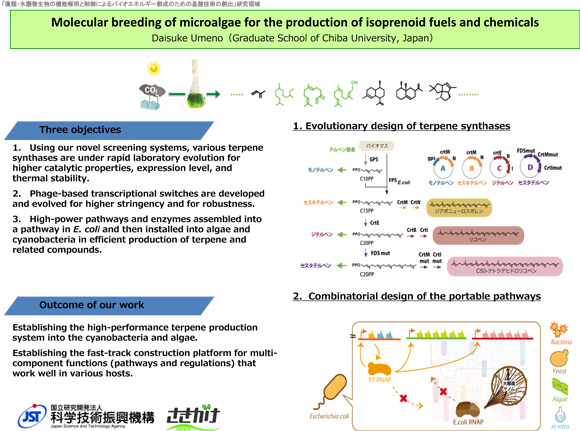
Shigeki Ehira

- Associate Professor, Department of Biological Sciences, Graduate school of Science and Engineering, Tokyo Metropolitan University
Metabolic engineering of differentiated cells of filamentous cyanobacteria for bioalcohol production
In many filamentous cyanobacteria such as Anabaena sp. PCC 7120, certain vegetative cells differentiate into heterocysts that are specialized cells for nitrogen fixation. Heterocysts are unable to carry out photosynthesis, and growth and division of heterocysts are ceased. In this study, I create differentiated cells specialized for alcohol production by metabolic engineering. Dividing the process of alcohol production from other cellular processes enables efficient bioconversion of CO2 into bioalcohol.
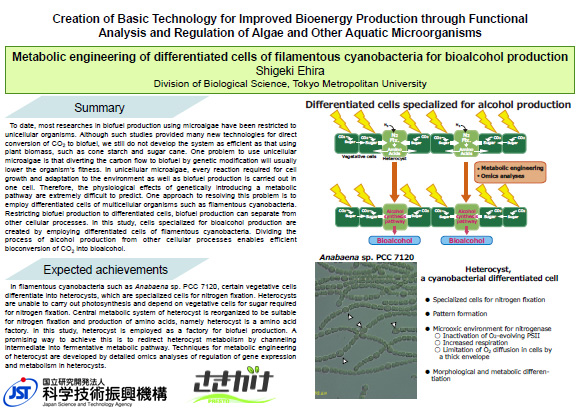
Takashi Tamura

- Professor, Graduate School of Natural Science and Technology, Okayama University
Molecular Design of a [NiFeSe]Hydrogenase that catalyzes H2 production under aerobic conditions
Fuel cell can generate ample electric power from hydrogen (H2) and air without burning resources, and is expected to provide an alternative energy source for increasing energy demand. Although H2 can be produced under anaerobic conditions by microbial fermentaion that involves hydrogenase (H2ase), several technical problems have to be solved for a large-scale H2 production by biological process. This project aims to alter the structure of air-vulnerable H2ase to highly impervious to oxygen-inactivation based on quantum chemical calculations using peta-flops supercomputer.
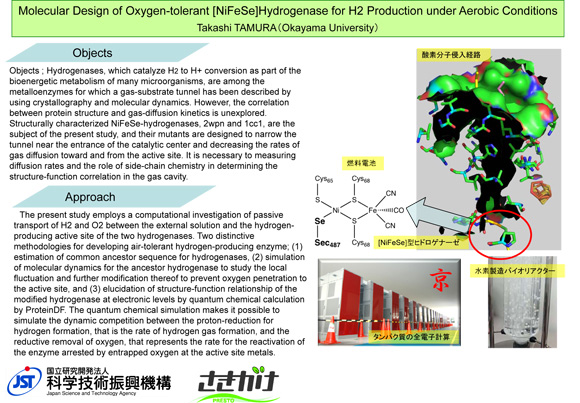
Motoki Tominaga

- Assistant Professor, Department of Biology, Faculty of Education and Integrated Arts and Science, Waseda University
Development of plant growth promoting system using the fastest motor Chara myosin
In this research, the velocity of cytoplasmic stereaming is artificially controlled by chimeric myosins fusing motor domain of the fastest Chara myosin XI or slower myosin V to Arabidossis myosin XI. Then the system is established for the artificial regulation of plant development. Because cytoplasmic streaming is common for intracellular transportation among plants, the system will be attempted as the powerful application for every plant especially involved in production of biomass and crops.
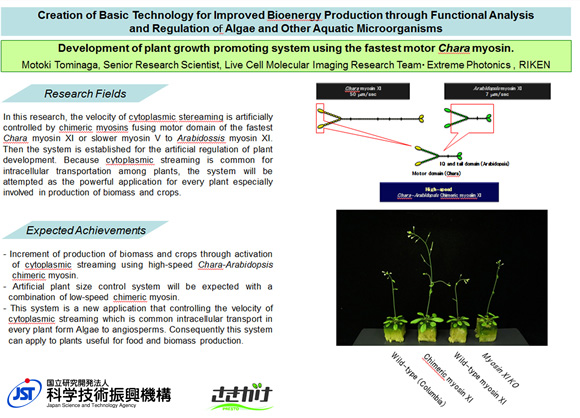
Masami Nakazawa

- Research associate, Graduate School of Life and Environmental Sciences, Osaka Prefecture University
Transformation in Euglena gracilis: application for biofuel production
Euglena gracilis, a kind of microalgae, is able to grow in high CO2 concentration atmosphere (up to 40%) in autotrophic and heterotrophic culture. E. gracilis accumulate wax ester, which can use for biofuel, as a result of fermentation. We are going to accomplish transformation and modification of E. gracilis, and produce carbon neutral biofuel.
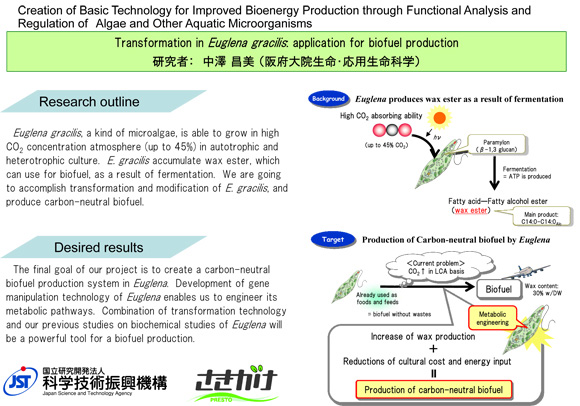
Rei Narikawa

- Lecturer, College of Science, Academic Institute, Shizuoka University
Light regulation of extracellular polysaccaride production by developing various photo-switches
In order to effectively perform photosynthetic reaction, photosynthetic organisms acclimate to changing light environments by using various photoreceptors.On the other hand, photosynthesis-based bioenergy production is recently significant issue. However, many improvements in the production efficiency are essential for practical utilization.In this study,by constructing novel combination of photoreceptor and regulatory system, I will develop various photo-switches to establish effective production of extracelllar polysaccarides.
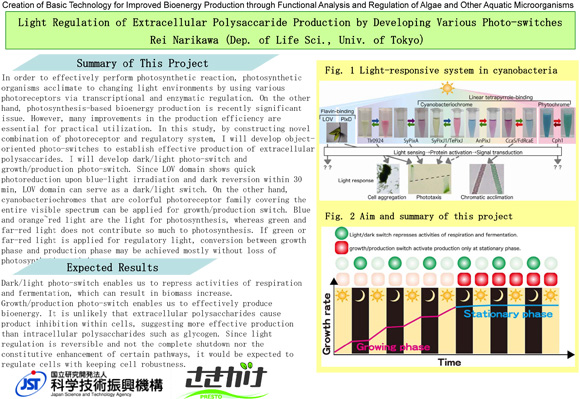
Ayumi Minoda

- Assistant professor, Graduate school of Life and Environmental Sciences, University of Tsukuba
Study on the development of a precious metal recycling system coupled with algae biofuel production by using thermophilic red algae
The aim of this project is the development of a precious metal recycling system coupled with algae biofuel production. For this purpose, thermophilic red algae are suitable materials due to a unique metal metabolism and the production of large quantity of biomass. To develop the system, their metal metabolism and carbon metabolism will be investigated. This project will contribute to the achievements of 100% presious metal recycling and carbon neutrality in the metal industry.
